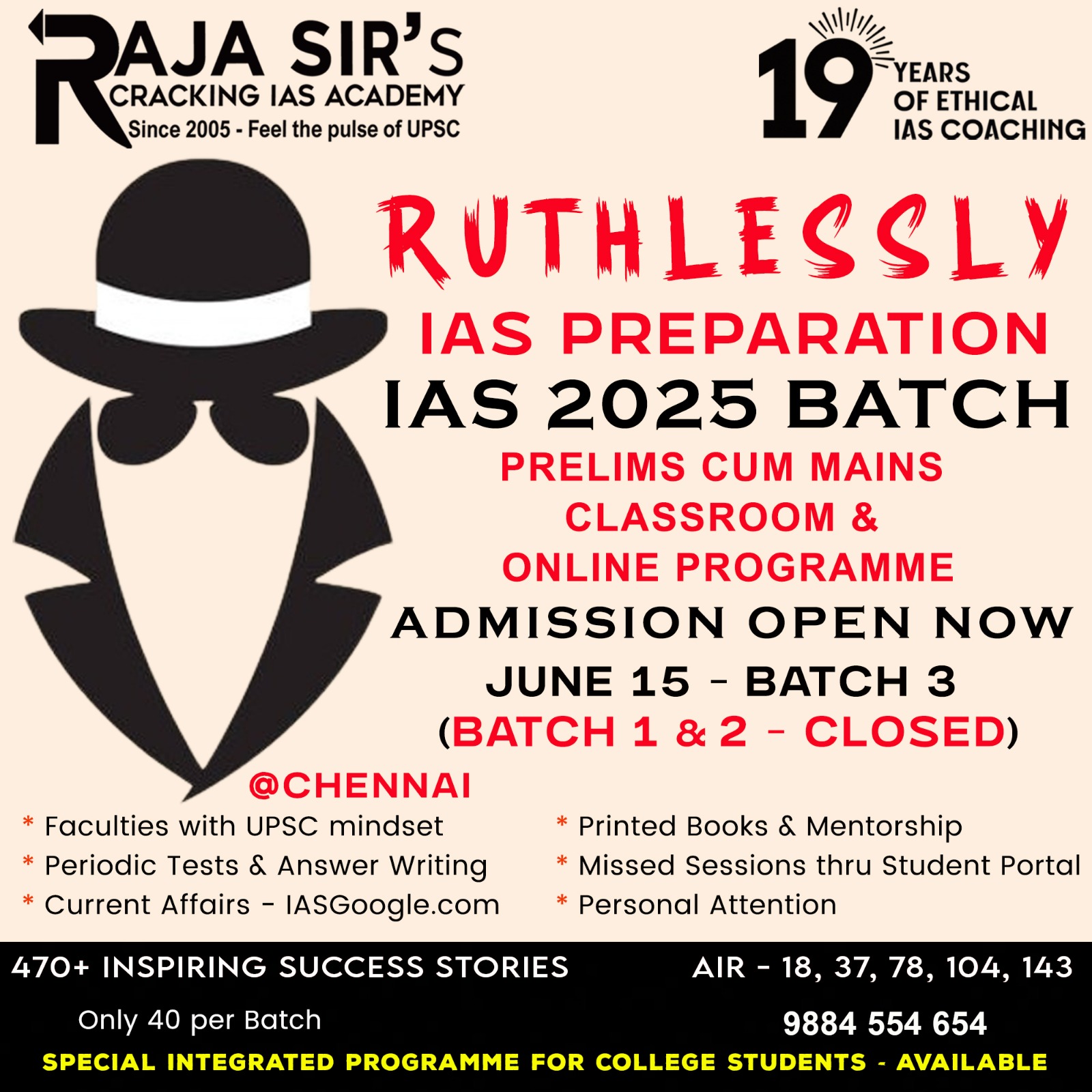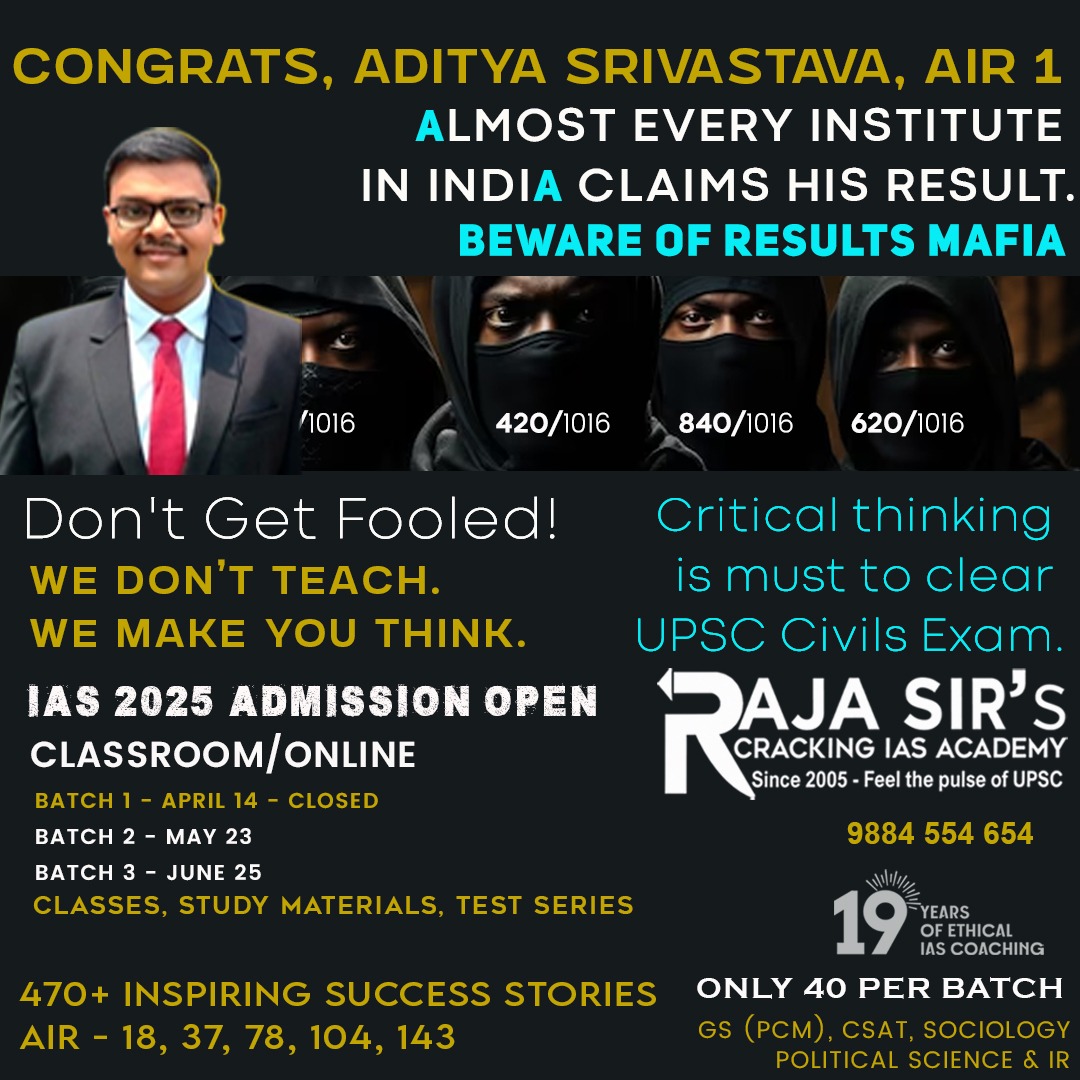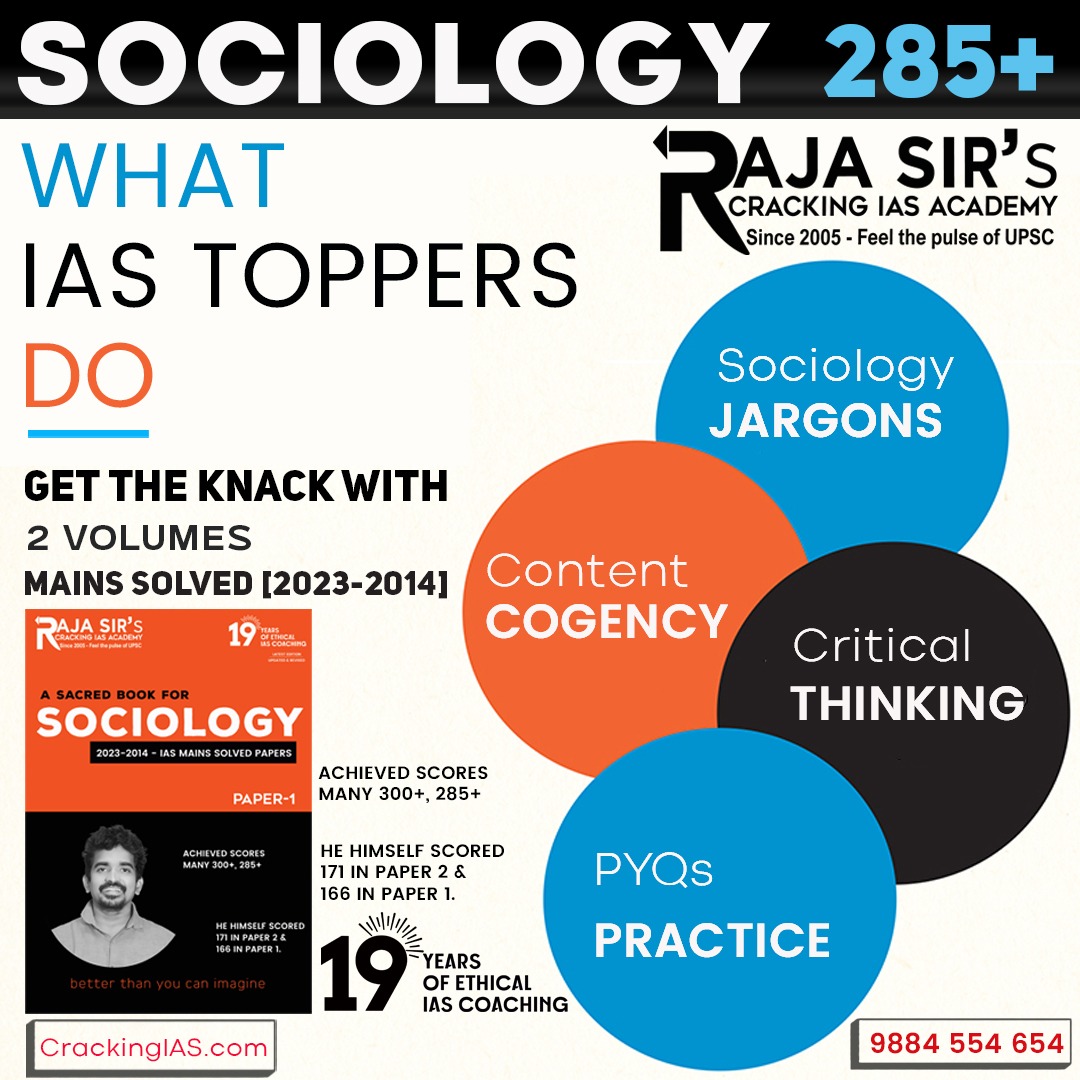- Home
- Prelims
- Mains
- Current Affairs
- Study Materials
- Test Series
 EDITORIALS & ARTICLES
EDITORIALS & ARTICLES
Hit List Questions 41- PPP 100 PRELIMS 2024 - 59
Questions & Explanations:
|
1. |
Consider the following statements w.r.t. Carbon nanotubes (CNTs). 1. Conventional methods of synthesising CNTs require high temperatures and metal catalysts such as Fe, Co and Ni catalysts which pose biocompatibility concerns for potential biomedical applications. 2. Carbon nanotubes have high thermal and electrical conductivity but very less mechanical strength. (a) Only 1 is true (b) Only 2 is true (c) Both 1 and 2 are true (d) Neither 1 nor 2 is true
|
|
||||||||||||||||||||||||||||||||||||||||||||||||||||||||||||||||||||
|
2. |
1. India 2. Bhutan 3. Suriname 4. Madagascar How many of these countries have attained Climate Neutrality? (a) Only two (b) Only one (c) All the four (d) Only three
|
|
||||||||||||||||||||||||||||||||||||||||||||||||||||||||||||||||||||
|
3. |
1. Mahendrapala 2. Rajyapala 3. Yashpala 4. Devapala Rulers of Gurjara-Pratiharas include (a) 1, 2 and 3 (b) 1 and 3 (c) 2, 3 and 4 (d) 1, 2. 3 and 4
|
|
||||||||||||||||||||||||||||||||||||||||||||||||||||||||||||||||||||
|
4. |
With reference to the art and archaeological history of India, which one among the following was made earliest? (a) Lingaraja Temple at Bhubaneswar (b) Rock-cut Elephant at Dhauli (c) Rock-cut Monuments at Mahabalipuram (d) Varaha Image at Udayagiri
|
|
||||||||||||||||||||||||||||||||||||||||||||||||||||||||||||||||||||
|
5. |
With reference to the Indian history of art and culture, consider the following pairs:
How many of the pairs given above is/are correctly matched? (a) Only 1 (b) Only 2 (c) All the three (d) None of these
|
|
||||||||||||||||||||||||||||||||||||||||||||||||||||||||||||||||||||
|
6. |
1. Shankaragana III 2. Gangeya-Deva 3. Kokalla 4. Laxmikarna Kings of Kalachuri dynasty include (a) 1, 2 and 3 (b) 1, 3 and 4 (c) 2, 3 and 4 (d) 1, 2. 3 and 4
|
|
||||||||||||||||||||||||||||||||||||||||||||||||||||||||||||||||||||
|
7. |
With reference to Sufism in Indian history, consider the following statements: 1. Shaikh Ahmad Sirhindi was a contemporary of Ibrahim Lodi. 2. Shaikh Nasiruddin Chirag-I-Dehlavi was a disciple of Shaikh Nizamuddin Auliya. 3. Aurangzeb was a contemporary of Shaikh Salim Chishti. 4. The Qadiri order of Sufi s was fi rst introduced in India by Shaikh Niamatullah and Makhdum Muhammad Jilani. Which of these statements are correct? (a) 1 and 2 (b) 1 and 3 (c) 2 and 3 (d) 2 and 4
|
|
||||||||||||||||||||||||||||||||||||||||||||||||||||||||||||||||||||
|
8. |
Which one of the following Muslim rulers was hailed as the ‘Jagadguru’ by his Muslim subject because of his belief in secularism? (a) Hussain Shah (b) Zain-ul -Abidin (c) Ibrahim Adil Shah (d) Mahmud II
|
|
||||||||||||||||||||||||||||||||||||||||||||||||||||||||||||||||||||
|
9. |
Chaitra 1 of the national calendar based on the Saka Era corresponds to which one of the following dates of the Gregorian calendar in a normal year of 365 days? (a) 22nd March (or 21st March) (b) 15th May (or 16th May) (c) 31st March (of 30th March) (d) 21st April (or 20th April)
|
|
||||||||||||||||||||||||||||||||||||||||||||||||||||||||||||||||||||
|
10. |
James Princep’s contribution in the development of the Indian epigraphy include I. He deciphered the Kharoshthi script used in most of the Ashokan inscriptions. II. He deciphered the Brahmi script used in most of the Ashokan inscriptions. Which of the above statements is/are true?. (a) Only (b) Only II (c) Both I & II (d) Neither I nor II
|
|
||||||||||||||||||||||||||||||||||||||||||||||||||||||||||||||||||||
|
11. |
Sayanacarya in Medieval Indian History refer to (a) a scholar (b) a painter (c) a musician (d) a military commander
|
|
||||||||||||||||||||||||||||||||||||||||||||||||||||||||||||||||||||
|
12. |
According to a rock inscription in Sanskrit, composed around second century CE the Sudarshana Lake was repaired by a king of the (a) Indo-Greeks (b) Kushanas (c) Satavahanas (d) Sakas o |
|
||||||||||||||||||||||||||||||||||||||||||||||||||||||||||||||||||||
|
13. |
The correct chronological order of the arrival of the following foreign travellers in India: I. William Hawkins II. Ralph Fitch III. Sir Thomas Roe IV. Nicholsa Dawnton Select the correct answer using the codes given below. Codes (a) II, I, IV and III (b) IV, II, I and III (c) I, III, II and IV (d) III, II, IV and I
|
|
||||||||||||||||||||||||||||||||||||||||||||||||||||||||||||||||||||
|
14. |
1. Priyadarshika 2. Nagananda 3. Harshacharita 4. Ratnavali Works authored by Harsha include (a) 1, 2, 3 and 4 (b) 1, 2 and 4 (c) 1, 2 and 3 (d) 2 and 3
|
|
||||||||||||||||||||||||||||||||||||||||||||||||||||||||||||||||||||
|
15. |
What does Hagiography refer to? (a) Writing of local people’s lives (b) Writing of saint’s lives (c) Writing of untouchable’s lives (d) Writing of king’s lives
|
|
||||||||||||||||||||||||||||||||||||||||||||||||||||||||||||||||||||
|
16. |
I. Graphite II. Fullerene III. Coke IV. Carborundum Allotropes of Carbon include Codes (a) II, III and IV (b) I and II only (c) I only (d) I, II, III and IV
|
|
||||||||||||||||||||||||||||||||||||||||||||||||||||||||||||||||||||
|
17. |
Consider the following statements about the North Atlantic Treaty Organization (NATO): 1. It was the US’s first peacetime military alliance outside the western hemisphere. 2. It is based on the principle of collective defence. 3. Its protection does not extend to members’ civil wars or internal coups. 4. Finland is a member in it. How many of the above statements is/are correct? (a) Only two (b) Only one (c) All the four (d) Only three
|
|
||||||||||||||||||||||||||||||||||||||||||||||||||||||||||||||||||||
|
18. |
Which one of the following animals was not represented on the seals and terracotta art of the Harappan culture? (a) Cow (b) Elephant (c) Rhinoceros (d) Tiger
|
|
||||||||||||||||||||||||||||||||||||||||||||||||||||||||||||||||||||
|
19. |
The Bhilsa Topes, published in 1854 trace the (a) Buddhist history (b) History of Jainism (c) Philosophy of Yoga (d) Philosophy of Caravaka
|
|
||||||||||||||||||||||||||||||||||||||||||||||||||||||||||||||||||||
|
20. |
Which of the following temples is an example of Wall inscriptions on which stories of Ramayana & the Mahabharata are inscribed? 1. Hazara temple 2. Vithalswami temple (a) 1 only (b) 2 only (c) Both 1 and 2 (d) Neither 1 nor 2
|
|
||||||||||||||||||||||||||||||||||||||||||||||||||||||||||||||||||||
|
21. |
1. Rakhal Das Banerjee 2. Dayaram Sahni 3. Ishwari Prasad 4. Ashirwadi Lal Srivastava Two Indians who were associated with discovery of Indus Valley Civilization include (a) 2 and 3 (b) 1 and 2 (c) 1 and 4 (d) 3 and 4
|
|
||||||||||||||||||||||||||||||||||||||||||||||||||||||||||||||||||||
|
22. |
According to the ‘Arthashastra’ of Kautilya, the following courts existed in the judicial system of the Mauryan Age 1. Dharmamahamatra 2. Dharmasthiya 3. Rajjuka 4. Kantakshodhana (a) 1 and 2 (b) 2 and 3 (c) 1 and 3 (d) 2 and 4
|
|
||||||||||||||||||||||||||||||||||||||||||||||||||||||||||||||||||||
|
23. |
Match List- I (Ancient site) with List- II Archaeological finding)
A B C D (a) 1 2 3 4 (b) 2 1 4 3 (c) 1 2 4 3 (d) 2 1 3 4
|
|
||||||||||||||||||||||||||||||||||||||||||||||||||||||||||||||||||||
|
24. |
1. It is a member of the World Bank Group. 2. It is the largest international development institution focused on the private sector in developing countries. 3. It lends directly to infrastructure and energy projects. 4. It had unveiled a policy requiring clients to reduce their exposure to coal projects by half by 2025, and to zero by 2030, and hence prevent new investments. Which of the statements given above is/are correct w.r.t. International Finance Corporation?. (a) 1 only (b) 1 and 3 (c) 1 and 2 (d) 1, 2, 3 and 4
|
|
||||||||||||||||||||||||||||||||||||||||||||||||||||||||||||||||||||
|
25. |
”Taj-ul-iqbal tarikh Bhopal” is the autobiography of (a) Sultan Jehan Begum (b) Tansen (c) Akbar II (d) Shahjehan Begum
|
|
||||||||||||||||||||||||||||||||||||||||||||||||||||||||||||||||||||
|
|
EXPLANATIONS |
|
||||||||||||||||||||||||||||||||||||||||||||||||||||||||||||||||||||
|
1. |
CNTs are tubular structures of carbon atoms arranged in an ordered manner. Carbon nanotubes have superlative properties, including high thermal and electrical conductivity, and very high mechanical strength. https://www.thehindubusinessline.com/business-tech/glass-meets-carbon/article67853068.ece |
A |
||||||||||||||||||||||||||||||||||||||||||||||||||||||||||||||||||||
|
2. |
https://www.weforum.org/agenda/2022/12/these-countries-achieved-net-zero-emissions/ |
D |
||||||||||||||||||||||||||||||||||||||||||||||||||||||||||||||||||||
|
3. |
https://iasgoogle.com/editorial_detail/the-gurjara-pratiharas-and-pala-dynasty |
A |
||||||||||||||||||||||||||||||||||||||||||||||||||||||||||||||||||||
|
4. |
Lingaraja Temple at Bhubaneshwar was built in 11 century A.D. Rockcut monuments at Mahabalipuram are 7 century AD creation. At Udaygiri, Varaha image is 5 th th century creation. Rock cut elephant at Dhauli was created during the reign of Ashoka (273-232BC). This is the oldest among the four. |
B |
||||||||||||||||||||||||||||||||||||||||||||||||||||||||||||||||||||
|
5. |
Mahaparinirvana: • The Mahaparinirvana of the Buddha in Cave 26, with numerous celestial musicians above and the sorrowful figures of his followers below, is one of the grandest expressive scenes with the grieving figure of Ananda near his feet is exceptional. • Ajanta Caves is a series of Rock-cut caves in the Sahyadri ranges on Waghora river Aurangabad in Maharashtra. • It consists of 29 Buddhist Caves of which 25 are viharas remaining 4 are Chaityas or prayer hall. • They were developed between 200 BC to 658AD. • They were built under the patronage of Vakataka Kings. • They are abundant with Fresco paintings, outlining in red colour, absence of blue colour, all themed around Buddhism. • It was designated as a UNESCO World Heritage site in 1983. Udaygiri caves: • Udaygiri caves are 20 Rock-cut caves near Vidisha Madhya Pradesh. • They were built near the fifth century and are the oldest surviving Hindu temples in India. • The sculpture of Vishnu in his incarnation as the male boar rescuing the mother earth presenting bhudevi to the boar’s tusk as depicted in Hindu mythology is present here. • They were built under the patronage of Gupta rulers. “Arjuna''s Penance”/ “Descent of Ganga” • The Monolithic sculpture was built under the reign of Pallava King Mahendra Varma located at Sri Sathya Perumal Temple. • It was built around 600-640 AD. • It is carved out of two huge boulders 27 meters long and 43 feet high and is the size of a huge blue whale. • Arjun, practising austerities to please Lord Shiva for obtaining a mighty weapon before the war of Kurukshetra is depicted in these structures. • The rock-cut sculpture has been fashioned to portray the penance done by King Bhagiratha, an ancestor of Lord Rama, to bring down the River Ganges from the heavens to the earth. Lord Vishnu, sages, celestial nymphs, Nagas, holy deities, Gandharvas, Yakshas, auspicious animals, and other divine entities are carved out in rock sculpture.
|
B |
||||||||||||||||||||||||||||||||||||||||||||||||||||||||||||||||||||
|
6. |
https://iasgoogle.com/editorial_detail/paramaras-chandelas-kalachuris-amp-sisodiyas |
d |
||||||||||||||||||||||||||||||||||||||||||||||||||||||||||||||||||||
|
7. |
Shaikh Ahmad Sirhindi also known as Mujaddid Alif Sani, was a famous saint of Naqshbandi order. He was a contemporary of Akbar and Jahangir. He propounded a positive philosophy (Wahdat-ul-Shuhud) over the mystic philosophy of God (Wahdat-ul-Wajud). Shaikh Nasiruddin Chirag-i-Dehlavi was one of the chief disciples of Khwaja Nizamuddin Auliya. He preached the teachings of his Pir (teacher), but he could not be as generous as him. Akbar was a contemporary of Shaikh Salim Chishti. Shaikh Mohiuddin Qadir Jilani of Baghdad was the fi rst founder of Qadri sect. He is counted among the great saints of Islam. Niamatullah and Makhdum Muhammad Jilani preached this sect in India during the 15th century. Makhdum Jilani made Uchha his center for education. |
D |
||||||||||||||||||||||||||||||||||||||||||||||||||||||||||||||||||||
|
8. |
Ibrahim Adil Shah-II was king of the Sultanate of Bijapur. Under his reign, the dynasty had its greatest period, as he extended its frontier to the south up to Mysore. He was a skilful administrator, artist, poet and a generous patron of arts. He reverted to the Sunni sect of Islam but remained tolerant of other religions. He is also known as Jagadguru Badshah. He founded a new township at Navraspur to give concrete shape to his idea of a musical city. He built a temple inside the precincts of the palace that still exists. IbrahimII wrote the book Kitab-i-Navras (Book of Nine Rasas) in Dakhani. |
C |
||||||||||||||||||||||||||||||||||||||||||||||||||||||||||||||||||||
|
9. |
The Saka Calender is based on luni-solar reckoning of time. The calendar consists of 365 days and 12 months like the normal Gregorian calendar. Chaitra is the first month of the year beginning on March 22 which is the day after the Spring Equinox. During leap years, the starting day of Chaitra corresponds with March 21.
|
A |
||||||||||||||||||||||||||||||||||||||||||||||||||||||||||||||||||||
|
10. |
James Prinsep (1799-1840) was an English scholar and antiquarian who made significant contributions to the fields of numismatics (the study of coins) and epigraphy (the study of inscriptions). He deciphered the Brahmi script used in ancient India and was responsible for the first accurate translations of many inscriptions found at archaeological sites in India. Prinsep also served as the assay master at the Royal Mint in Calcutta and was a founding member of the Royal Asiatic Society of Great Britain and Ireland. |
C |
||||||||||||||||||||||||||||||||||||||||||||||||||||||||||||||||||||
|
11. |
Sayaṇa was a Sanskrit-language writer and commentator, and more than a hundred works are attributed to him, among which are commentaries on nearly all parts of the Vedas. There are about 50 commentators on Vedic texts. However, the credit of writing commentaries on most of the Vedic texts goes to Sayanacarya. The complete bhashyam on all the four Vedas was done by Sayanacarya in the fourteenth century, and not before. Sayanacarya is the only authority, who commented on all the four Vedas - their Samhita, Brahmana and few Aranyakas. He wrote on many other subjects also. Undoubtedly, he is the undisputed authority on the Vedas. Sayana belongs to the period of Emperor Harihara, the founder of the Vijayanagar Empire. He held the post of prime minister for sixteen years (1363-1379) during the 35 years of rule of his son Emperor Bukka (1344-1379). |
A |
||||||||||||||||||||||||||||||||||||||||||||||||||||||||||||||||||||
|
12. |
The Junagarh inscription gives the information about the Sudarshan lake that the lake was an artificial reservoir, was built by the Mauryan emperors for checking floods. Around 150 AD, the lake was repaired by the Shaka ruler Rudradaman-I. According to a rock inscription in Sanskrit composed around the second century CE, the Sudarshana lake was repaired by a king of the Shakas. This inscription provides valuable historical information about the ruler who undertook the renovation and sheds light on the political and cultural context of the time. The Sudarshana lake is mentioned in an inscription found on a rock, which is written in the Sanskrit language. The inscription states that the lake was repaired by a king of the Shakas. Let us understand the significance of this information and its historical context. The Sudarshana Lake: - The Sudarshana lake is believed to be located in present-day Maharashtra, India. - It is mentioned in various ancient texts and inscriptions as a prominent water body. - The lake likely played a crucial role in irrigation, agriculture, and the overall economy of the region. The Shakas: - The Shakas were a group of Central Asian nomadic tribes who migrated to the northwestern regions of the Indian subcontinent. - They established their rule in various parts of India during the first and second centuries CE. - The Shakas were known for their military prowess and engaged in conflicts with other ruling dynasties of the time. Historical Context: - The repair of the Sudarshana lake by a Shaka king suggests their influence and presence in the region. - It indicates that the Shakas had established political control over the area where the lake was situated. - This inscription provides evidence of the Shaka king''s commitment to the welfare and development of the region by undertaking the repair of a significant water source. - It reflects the importance of water management and infrastructure during this period. The inscription in Sanskrit, dating back to the second century CE, reveals that the Sudarshana lake was repaired by a king of the Shakas. This information contributes to our understanding of the Shakas'' presence in the region and their efforts to maintain and develop important water resources. |
D |
||||||||||||||||||||||||||||||||||||||||||||||||||||||||||||||||||||
|
13. |
William Hawkins- He arrived in Surat in August 1608. Ralph Fith - He came to India in 1583. Sir Thomas Roe - Roe arrived at the port of Surat in September 1615 with a letter from King James I to the then reigning Mughal Emperor, Jahangir, seeking a trade agreement. Nicholas Dawnton - He arrived in India in 1614. |
A |
||||||||||||||||||||||||||||||||||||||||||||||||||||||||||||||||||||
|
14. |
King Harshavardhana
Harshacharita
|
B |
||||||||||||||||||||||||||||||||||||||||||||||||||||||||||||||||||||
|
15. |
A hagiography is a biography of a saint or an ecclesiastical leader. The term hagiography may be used to refer to the adulatory and idealized biography of a founder, saint, monk, nun or icon in any of the world''s religions. The Digambara sect of Jainism make use of the term ‘Purana’ for the hagiographies. Whereas, the Shvetambara sect use the term ‘Charita’. With respect to the hagiography of Mahavira, both the sects differ to a great extent.
|
B |
||||||||||||||||||||||||||||||||||||||||||||||||||||||||||||||||||||
|
16. |
Allotropy is the property of some chemical elements to exist in two or more different forms, in the same physical state. Diamond, graphite and fullerenes (substances that include nanotubes and buckminsterfullerene) are the important allotropes of pure carbon. Carborundum is Sillicon Carbide (SiC), and hence, is not an allotrope of carbon. Coke is an amorphous solid, graphite is a crystalline solid. While graphite is an allotrope of carbon (diamond and buckminsterfullerenes being others), coke is the name for a fuel that contains mostly carbon with a few impurities. Coke is not an allotrope of carbon. |
A |
||||||||||||||||||||||||||||||||||||||||||||||||||||||||||||||||||||
|
17. |
C |
|||||||||||||||||||||||||||||||||||||||||||||||||||||||||||||||||||||
|
18. |
The seals and terracotta art of the Harappan culture show pictures of animals like elephants, rhinos, tigers, deer, and sheep. However, cows are not shown in these artworks. |
a |
||||||||||||||||||||||||||||||||||||||||||||||||||||||||||||||||||||
|
19. |
|
A |
||||||||||||||||||||||||||||||||||||||||||||||||||||||||||||||||||||
|
20. |
C |
|||||||||||||||||||||||||||||||||||||||||||||||||||||||||||||||||||||
|
21. |
Rakhaldas Bandyopadhyay was born on 12 April 1885. He is often addressed as called R D Banerji. He was a prominent Indian Prehistorian and Historical expert. He is generally known as the pioneer of Mohenjodaro, the chief site of the Harappa culture. Bandyopadhyay is well known for uncovering pre-Buddhist ancient rarities at the vestiges at Mohenjodaro. He was well known for taking note of similitudes between the site at Mohenjo-Daro and Harappa. Those revelations led to unearthings at the two destinations that set up the presence of the then-obscure Bronze Age Indus Valley Civilisation. His translations of this civilisation were distributed in various articles and books. Some of his works include, "An Indian City 5,000 Years Prior", "Mohenjo-Daro", Ancient, Old and Hindu India and Mahenjodaro – A Failed to remember Report.
|
B |
||||||||||||||||||||||||||||||||||||||||||||||||||||||||||||||||||||
|
22. |
The Arthashastra mentions two types of courts: Dharmasthiya which is analogous with modern civil courts and Kantakshodhana which is analogous to modern criminal courts. |
D |
||||||||||||||||||||||||||||||||||||||||||||||||||||||||||||||||||||
|
23. |
|
B |
||||||||||||||||||||||||||||||||||||||||||||||||||||||||||||||||||||
|
24. |
The International Finance Corporation is an international financial institution that offers investment, advisory, and asset-management services to encourage private-sector development in less developed countries. The IFC is a member of the World Bank Group and is headquartered in Washington, D.C. in the United States. |
C |
||||||||||||||||||||||||||||||||||||||||||||||||||||||||||||||||||||
|
25. |
Nineteenth-century Europeans were very interested in the stupa at Sanchi. In fact, the French sought Shahjehan Begum’s permission to take away the eastern gateway, which was the best preserved, to be displayed in a museum in France. For a while some Englishmen also wanted to do the same, but fortunately both the French and the English were satisfied with carefully prepared plaster-cast copies and the original remained at the site, part of the Bhopal state. The rulers of Bhopal, Shahjehan Begum and her successor Sultan Jehan Begum, provided money for the preservation of the ancient site. No wonder then that John Marshall dedicated his important volumes on Sanchi to Sultan Jehan. She funded the museum that was built there as well as the guesthouse where he lived and wrote the volumes. She also funded the publication of the volumes. So if the stupa complex has survived, it is in no small measure due to wise decisions, and to good luck in escaping the eyes of railway contractors, builders, and those looking for finds to carry away to the museums of Europe. One of the most important Buddhist centres, the discovery of Sanchi has vastly transformed our understanding of early Buddhism. Today it stands testimony to the successful restoration and preservation of a key archaeological site by the Archaeological Survey of India. |
D |









 Latest News
Latest News




 General Studies
General Studies